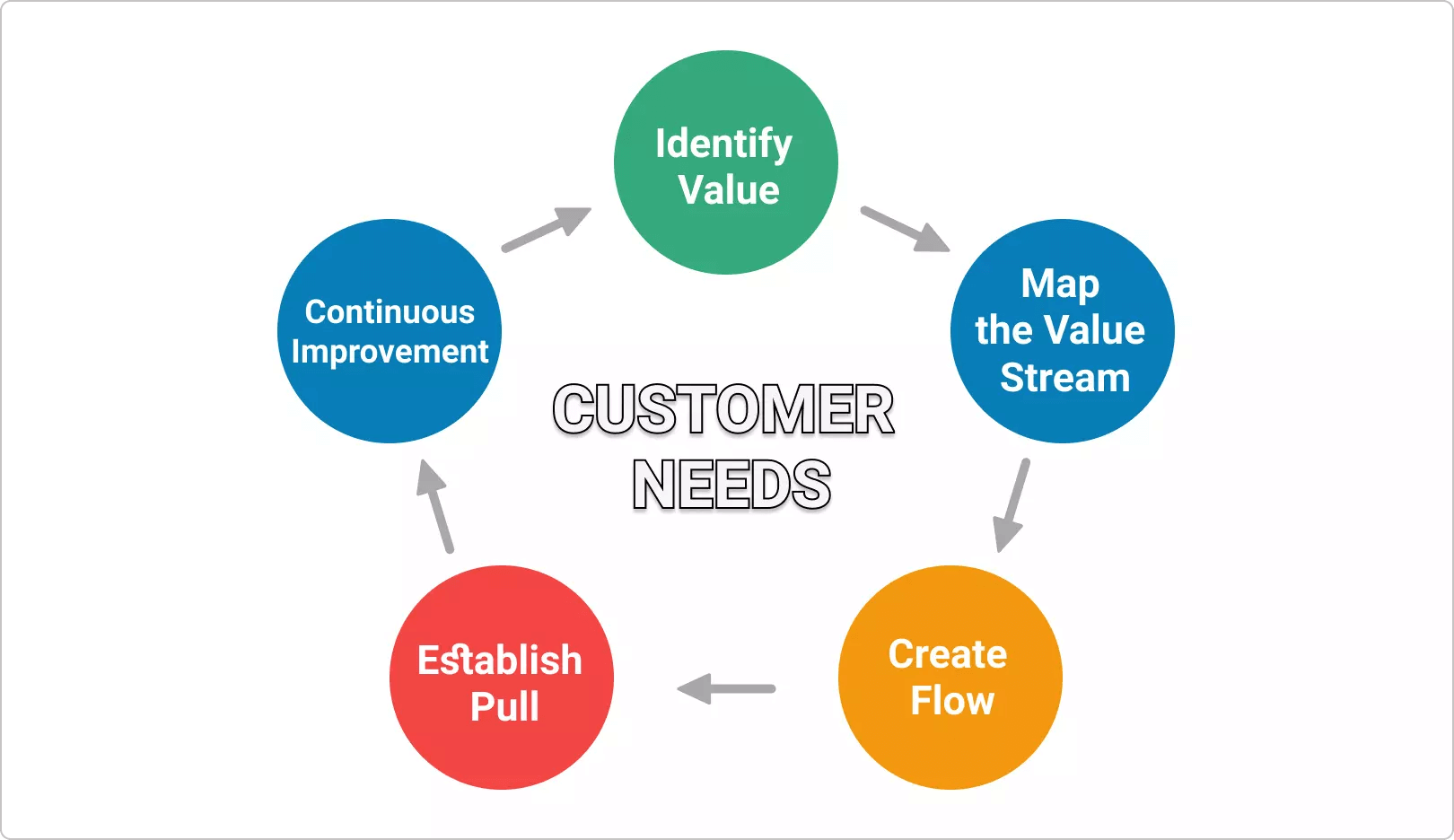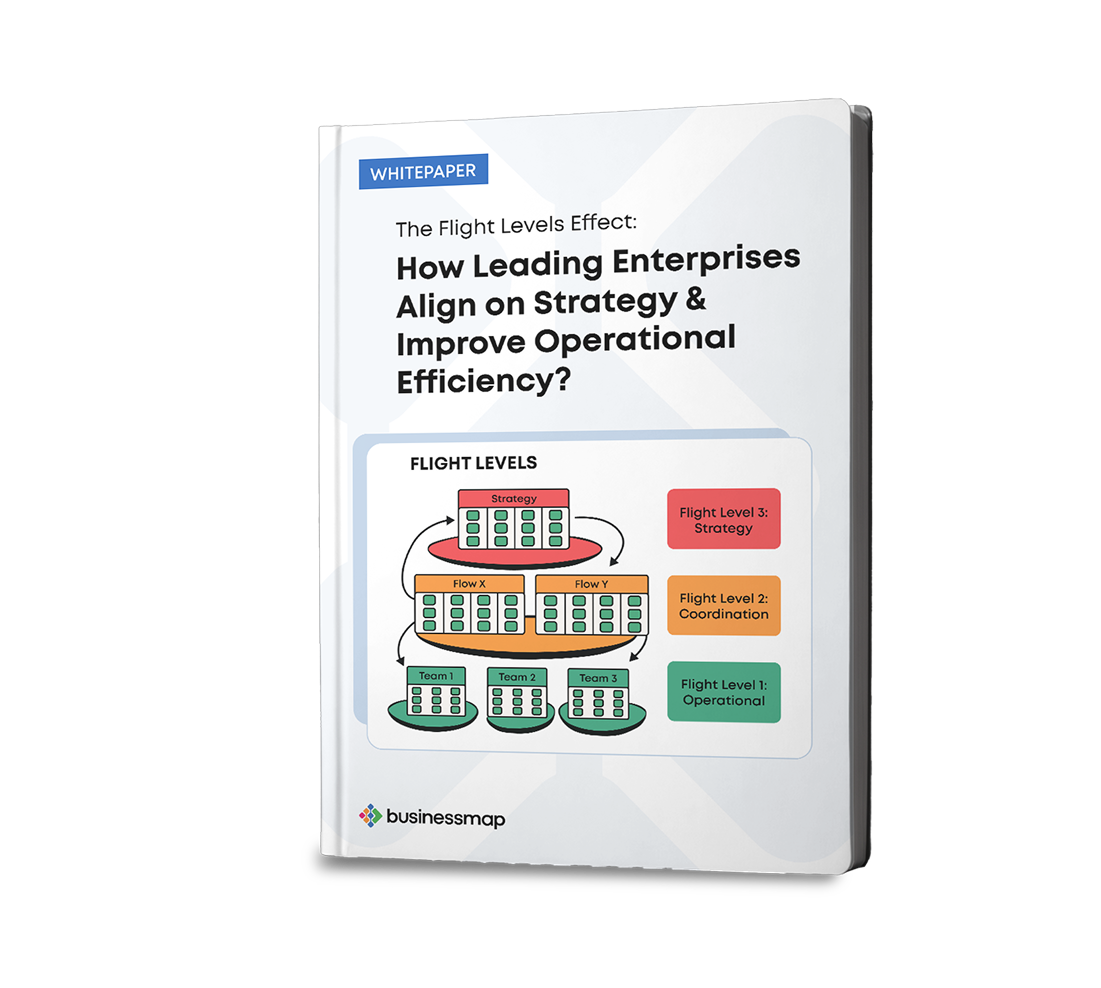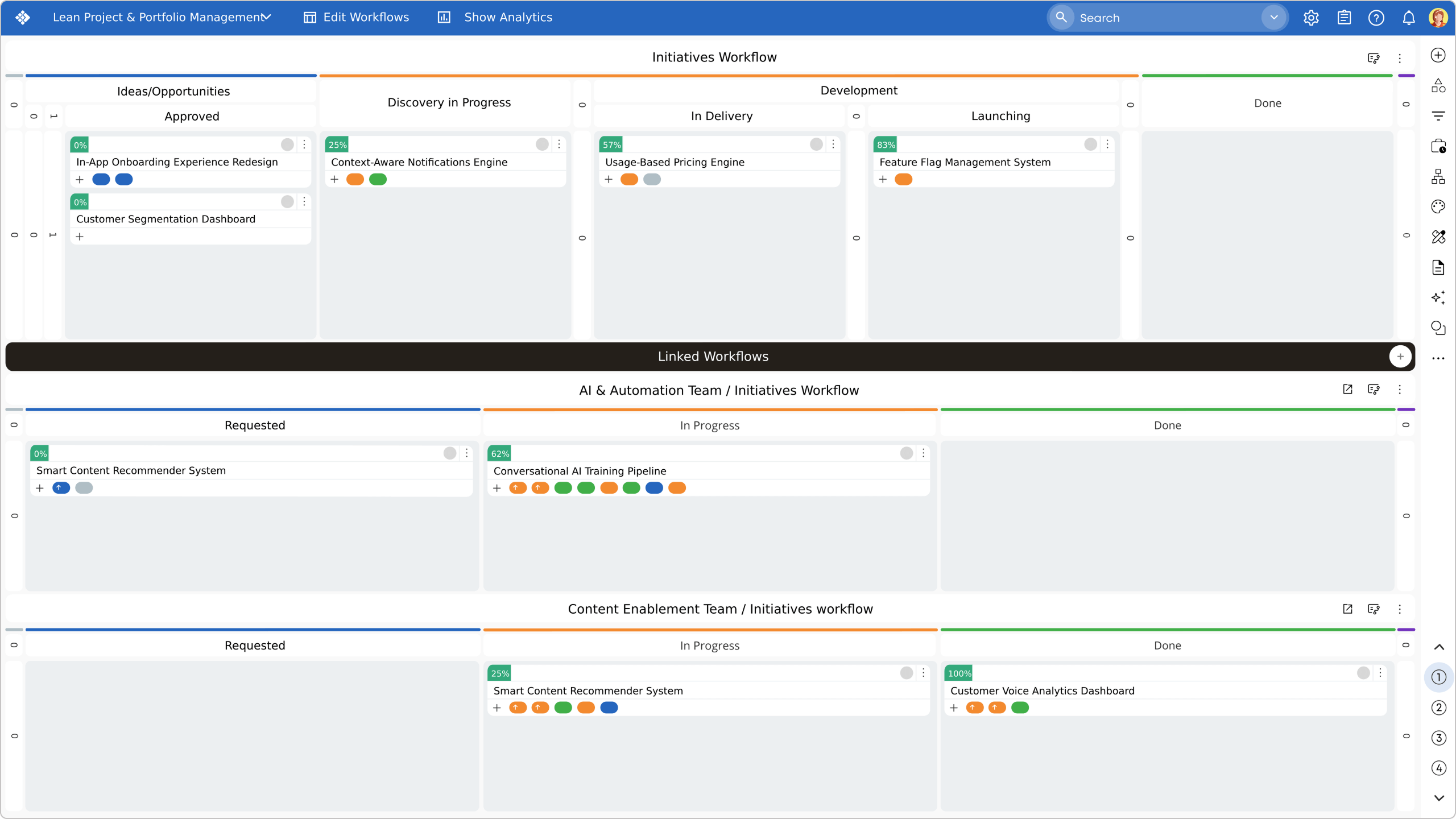Key Takeaways
-
Lean Portfolio Management aligns strategic goals with execution using Agile, Lean, and systems-thinking principles.
-
LPM focuses on optimizing the flow of value across initiatives, not just completing projects.
-
LPM tools create real-time visibility, improve prioritization, and enable faster, data-driven decisions.
- Modern tools support scenario planning, portfolio Kanban, OKRs, governance, and analytics at scale.
What Is Lean Portfolio Management (LPM)?
Lean Portfolio Management is an evolution of traditional portfolio management that draws from Lean thinking to optimize how organizations manage multiple projects and strategic initiatives. The goal is to create a system where time, funding, and talent are allocated to the work that delivers the highest business value, removing waste, and enabling more adaptive planning.
LPM operates through three core pillars:
-
Strategy & Investment Funding: Aligning funding and prioritization with strategic goals. It involves defining the strategic themes, goals, and initiatives that drive the portfolio.
-
Lean Governance: Refers to activities such as overseeing spending, conducting audits, ensuring compliance, managing expenditures, and measuring performance.

What Are Lean Portfolio Management Tools?
Lean Portfolio Management tools operationalize LPM by integrating strategy, planning, execution, and governance into a single system. These platforms replace spreadsheets, siloed tools, and manual reporting with real-time visibility and automated workflows.
Modern LPM tools centralize:
- Strategic goal setting and OKRs
- Portfolio and program-level initiatives
- Scenario planning and capacity insights
- Real-time analytics and dashboards
- AI-driven insights
- Lean governance workflows
Why Lean Portfolio Management Matters
Companies and teams today face faster change, greater complexity, and increasing pressure to justify investments. LPM helps navigate all that through:
-
Business agility: Enables organizations to respond faster to changes.
-
Better decisions: Supports informed choices through continuous use of data and actively accepting ideas and feedback.
-
Maximum value: Enables prioritization based on data-driven factors, so teams focus on delivering what matters most.
-
Innovation culture: Lean and Agile principles are rooted in experimentation, learning, and collaboration.
How LPM Enables Adaptive Funding & Prioritization
Traditional annual budgets quickly become outdated. In contrast, LPM enables continuous, value-based funding, allowing organizations to reroute investment toward the most important goals.
Lean portfolio tools support this shift by:
- Mapping strategic themes and initiatives
- Visualizing value streams and dependencies
- Providing real-time portfolio health and performance trends
- Supporting incremental funding cycles
- Proving scenario simulations for investment trade-offs
With LPM software, organizations move from reactive planning to adaptive decision-making.
How to Implement Lean Portfolio Management
Most importantly, implementing Lean management requires an organizational mindset shift and the right foundational practices:
1. Define Clear Strategic Objectives
Start with a shared vision. This is the guiding principle for prioritizing projects in your portfolio.
2. Establish Lean Governance
Create simple governance structures that support speed and accountability.
3. Adopt Value Stream Thinking
Look at the big picture. Treat your portfolio as a series of interconnected value streams.
4. Integrate Agile Execution Models
Use Kanban, Scrum, or hybrid models to support team agility.
5. Measure & Adapt Continuously
Use OKRs and portfolio flow metrics to guide decisions and identify opportunities for improvement.
How Is LPM Different from Traditional Portfolio Management?
LPM is built for modern, fast-paced environments. It replaces top-down command with agility and shifts from rigid annual planning to value-driven portfolio prioritization.
| Traditional Portfolio Management |
Lean Portfolio Management |
| Hierarchical, centralized decisions |
Decentralized, empowered teams |
| Annual/big-bang planning cycles |
Continuous, adaptive planning |
| Project-based funding |
Value-stream-based funding |
| Focus on output delivery |
Focus on outcome and customer value |
| Detailed business cases |
Lightweight MVP-based business justification |
Flight Levels in Action: Use Cases & Guide
How Enterprises Align on Strategy with Flight Levels
Lean Portfolio Management Tools: Essential Capabilities
Organizations evaluating LPM tools should look for platforms that provide:
- Strategy & OKR alignment
- Portfolio visualization
- Scenario planning and what-if simulations
- Dependency and capacity insights
- Flow-based analytics and forecasting
- Executive dashboards
- Workflow flexibility for hybrid or Agile delivery
- AI decision support
The Best Lean Portfolio Management Tools in 2026
1. Businessmap
The #1 Lean Portfolio Management Tool for Strategy-to-Execution Alignment
Businessmap is a well-established Lean portfolio management platform built to give enterprises full visibility, coordination, and control. The PPM system adapts to your workflows, whether Agile, hybrid, or traditional, and maintains deep Lean capabilities.
Strenghts
-
AI-powered strategy mapping: Visualize strategic goals on collaborative AI-enabled canvases
-
Portfolio & coordination boards: Track initiatives, dependencies, and priorities across projects, programs, and portfolios
-
Built-in OKRs tied directly to execution
-
Advanced Lean metrics & analytics: Cycle time, flow efficiency, throughput, forecasting
-
Executive dashboards for real-time insights into KPIs, OKRs, and portfolio health data
-
Flexible workflows that fit any delivery model
-
Affordable enterprise pricing without feature limitations
-
14-day free trial and transparent tiered subscription pricing model
Businessmap is ideal for organizations seeking a practical and flexible tool to support organizational transformations toward a connected value delivery system.
→ Businessmap is featured in the Gartner Peer Insights category for PPM
 Visualizing Lean project and portfolio management board in Businessmap
Visualizing Lean project and portfolio management board in Businessmap
Master Lean Portfolio Management
2. Planview
Planview is an all-around solution for enterprise-wide portfolio planning, resource management, and scenario modeling. Strong for large organizations requiring deep financial controls.
Strengths
- Advanced financial and resource modeling
- Strategic planning and OKR alignment
- Scenario planning for investment trade-offs
- Executive dashboards and BI-grade analytics
- Strong governance controls
3. Jira Align
Ideal for enterprises already committed to the Atlassian ecosystem and looking to scale Agile. Strong integration with team-level Jira instances; best for SAFe adoption.
Strengths
- Native integration with Jira
- Visibility across Agile teams, trains, and portfolios
- PI planning, roadmap alignment, and dependency mapping
- Agile-centric governance and reporting
4. Apptio Targetprocess
A visual enterprise agile planning platform that aligns strategic goals with execution, which offers work visualization, resource management, portfolio budgeting, OKR dashboards, and hybrid agile/SAFe workflows.
Strengths
- Program management
- Portfolio budgeting
- Resource management
- Strategic planning
5. Kiplot
Kiplot is a web application providing Lean, Agile, and project portfolio management solutions featuring customizable views and real-time visualizations. It offers live data integrations with systems like Jira and supports hybrid agile/waterfall work.
Strengths
- Aligning portfolio initiatives with enterprise strategy
- OKR Alignment & Tracking
- Customizable Portfolio Kanban
- Scoring models
- What-if scenario planning with AI recommendations (added to advanced plans)
Common Use Cases for Lean Portfolio Management Tools
1. Strategic Alignment with OKRs
Ensure all portfolio investments map directly to measurable outcomes.
2. Value-Based Prioritization
Use data-driven frameworks such as Cost of Delay, ROI, or risk scoring to choose what to fund next.
3. Portfolio Flow Optimization
Identify bottlenecks and reduce cycle time with Lean metrics.
4. Capacity & Demand Management
Balance resources across teams and portfolios before committing to new initiatives.
5. Cross-Team Coordination
Visualize work dependencies, risks, and timelines.
6. Continuous Funding & Governance
Move from annual budgets to adaptive, Lean funding cycles.
How to Choose a Lean Portfolio Management Tool
As you compare tools, consider the following evaluation criteria:
- Strategic alignment capabilities (OKRs, dashboards)
- Portfolio visualization & Kanban support
- Flexibility of workflows
- Lean/Agile analytics
- AI forecasting and decision support
- Integration ecosystem
- Scalability
- Ease of adoption and UX
- Pricing transparency
For most organizations seeking Lean portfolio management, Businessmap offers the best combination of capabilities, price, and adaptability.
"Businessmap has become a cornerstone of our transformation toward a connected, end-to-end value delivery system."
Source: Gartner Peer Insights
FAQs
Who is involved in Lean Portfolio Management?
Portfolio owners, lean portfolio managers, business owners, Agile operations teams, and cross-functional Agile teams all play a role in aligning strategy and execution.
How do you measure LPM success?
LPM success is measured by combining OKRs, flow metrics, and Lean-Agile outcomes to track value delivery, efficiency, and strategic alignment. Additionally, budgeting plays a crucial role by enabling dynamic funding and tracking of planned versus actual spend, ensuring investments align with strategic goals and maximize portfolio value.
How do Lean, Agile, and Systems Thinking intersect in LPM?
Lean provides value and flow focus, Agile enables adaptability, and systems thinking ensures decisions consider the full organizational ecosystem.
Which Lean portfolio management tools best align strategy with agile execution and value stream funding?
Businessmap excels with end-to-end hierarchy linking and flow-based funding insights for continuous value delivery.
What features do LPM tools offer for backlog prioritization, WIP limits, and real-time portfolio visibility?
Leading LPM tools include backlog scoring models, planning modules, dependency management, portfolio Kanban boards, and real-time dashboards for monitoring flow and progress.
How do Lean portfolio management tools support decentralized decision-making and faster time-to-market?
They provide shared visibility, explicit policies, and real-time metrics that enable teams to make data-informed decisions without waiting for top-down approvals. With connected value streams, organizations reduce delays and accelerate delivery.
Which LPM tools provide risk management, continuous improvement metrics, and resource optimization?
Businessmap and Planview offer strong capabilities in risk visibility, flow-based continuous improvement, and resource capacity planning. Businessmap stands out with its integrated blocker analytics, Monte Carlo forecasting, and real-time resource insights.
Are there free trials or demos for LPM tools?
Yes. Businessmap offers a 14-day free trial and guided demos. Targetprocess also offers a free trial. Planview and Jira Align typically offer personalized demos rather than free trials.
Ready to see Businessmap in action?







 Visualizing Lean project and portfolio management board in Businessmap
Visualizing Lean project and portfolio management board in Businessmap

